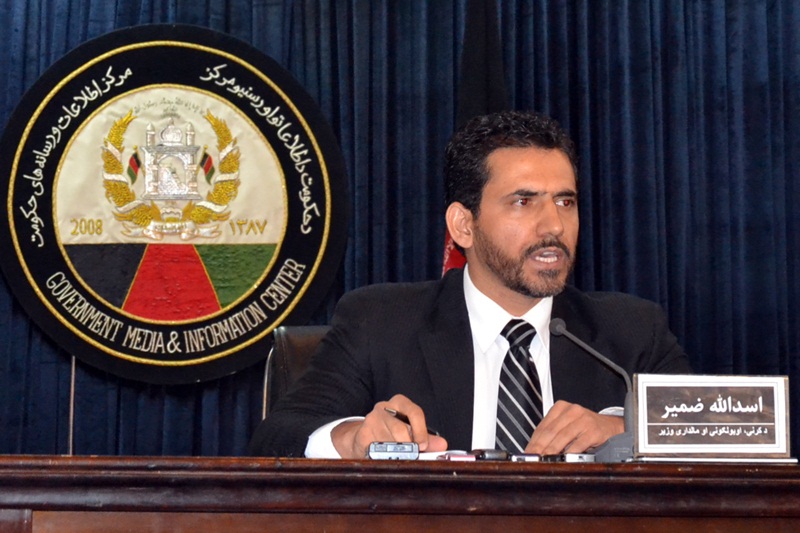2.5 million Afghans live below poverty line, says UN
By Akhtar M. Nikzad-KABUL: Deputy Minister for Agriculture, Irrigation and Livestock (MAIL) on Tuesday said that without ensuring water security there would be no food security.
The Deputy Minister Amanuddin Haidari said this in his speech to a gathering on the 35th anniversary of the World Food Day, celebrated by the UN Food Agriculture Organization (FAO) and the MAIL here in Kabul. Theme of this year observance was “Social Protection and Agriculture: Breaking the cycle of rural poverty” highlighting the importance of agriculture in social protection and diminishing the level of rural poverty.
Haidari said that there has been tremendous improvement in agriculture sector as production of grain, fruit, vegetables and other necessities increased.
He said, “In order to achieve food security for Afghanistan, we need water security first. It is essential to create better coordination between land and water resource managers for better utilization of water and soil resources.”
He said that 2.5 million people in Afghanistan live below the poverty line and need aid on emergency basis. Around 1.53 million people face food insecurity and 7.53 million is threatened by food insecurity and need enough income and food.
The welfare organizations can provide humanitarian aid to only 2.1 million people, Haidari said, adding that The achievements in agriculture sector is considerable but the poverty rate is increasing due to lack of job opportunities. Most of the poor people live in rural areas. The displaced people need urgent aid.
He said that for the next year the ministry of agriculture has special programs for improvement of rural people’s livelihood, but implementation of the programs without support of international partners would be difficult and impossible.
According to a survey of the International Patent Classification (IPC), in Afghanistan Ghor, Paktika, Zabul, Takhar, Bamyan, Badakhshan, Badghis, Samangan and Nuristan provinces need food aid.
Deputy Country Director of FAO for Afghanistan, Gordon Criag, said that one month ago the United Nations member states formally adopted a post-2015 Sustainable Development Agenda. This agenda will serve as the strategy framework for global development cooperation during the next 15 years.
According to him the agenda calls on the member states to end hunger, achieve food security and improve nutrition and promote sustainable agriculture. “This means addressing the needs of the 800 million people in the world today who still suffer from hunger and the people who lack the nutrition necessary to lead healthy lives.”
“I would like to emphasize at this point we are committed to helping the most vulnerable Afghans and well do so in the following way: as providing facility for public health especially malnutrition, collaboration with Afghan National Disaster Management Authority to respond to emergencies, providing children with meals at school that are full of nutrition, establishment of a factory in Kabul to produce specialized food,” he said.
Ministry of Energy and Water, Ali Ahmad Osmani, acknowledged that to achieve food security for Afghanistan we need water security first.
He added that it is essential to create better coordination between land and water resource management for better utilization of water and soil resources.
Last month, the United Nations and its partner agencies said that a large number of Afghan people have resorted to selling their properties or turned to relatives and friends for help as food insecurity doubled in the last year.
The Food Security and Agriculture Cluster (FSAC), a non-profit organization in Afghanistan, in its report “The 2015 Seasonal Food Security Assessment in Afghanistan (SFSA)” said that at the peak of the lean season the number of Afghans facing severe food insecurity increased from 4.7 percent of the population 12 months ago to 5.9 per cent today.
This means more than 1.5 million people are now considered severely food insecure, an increase of more than 317,000. Another 7.3 million people – more than one in every four Afghans – are classed as moderately food insecure, found the report.
Of greatest concern is the finding that the proportion of severely food insecure people who have already exhausted their capacity to cope with these emergencies has increased – meaning many more are now forced to sell land, take children out of school to work, or depend on relatives for support, it said.
The SFSA report indicates that the number of people engaged in these last ditch actions has doubled over the past year to more than 20 per cent of food insecure people across the country.
This will leave even more Afghan people significantly vulnerable to extreme poverty.
The report shows that female-headed households are almost 50 per cent more likely to be severely food insecure than other households in Afghanistan, having a much poorer diet than their peers and a much lower income.
It is striking to know that one third of the Afghan population is food insecure and their situation continues to worsen, said Assadullah Zamir, Minister of Agriculture, Irrigation and Livestock.
 Afghanistan Times
Afghanistan Times




